In yet another stunning confession… I’ve played around with pasta alla carbonara myself, doing strange things to it. I admit it. And I’ve even called it a carbonara on occasion.
Off-hand, I know we’ve served twisted versions of carbonara twice at Casa SaltShaker…
A simple, classic carbonara, but then topped with sauteed baby portobellos, caramelized onions, and celery leaves.
A very non-classic version using lamb bacon rather than pork (several customers having requested no pork), and adding a puree of sun-dried tomatoes and a splash of cream into the final sauce, and then tossed at the end with some jalapeño, rosemary, and black olives. Not really carbonara, that was merely the springboard.
[Others have these same discussions, see this recent one from friends Aki & Alex over at the Ideas in Food blog.]
But enough about me, let’s get back to checking out the good, the bad, and the ugly of carbonara in the Buenos Aires restaurant world….
My first stop, I headed towards the Recova, where according to various online diner reviews, the best carbonara could be found at either Piegari or La Stampa. Funny that, since neither of them offer carbonara on their menu, and at least at La Stampa they told me they never have. But, Sorrento, Posadas 1053, Retiro, does, so I thought I’d give it a try… even though upfront the menu noted that the sauce was made with “cream, egg yolk, and bacon”. We’ve had this cream conversation. But hey, maybe it’s just a splash, right? [Closed, replaced by another Italian spot, Fechoría.]
No, it’s not. In fact, as best I could tell, this was basically nothing more than reduced cream with a small amount of diced bacon, barely warmed (what you see in the photo is about as much as there was), and maybe an egg yolk in there – but the sauce was so white, I have my doubts. Cheese and pepper added after the fact, offered by the waiter. Pretty much a bland failure all around. The only saving grace being quite properly al dente pasta. 270 pesos… but they also have a 65 peso/person cubierto charge, so it’s really 335 pesos. Even at less it would have been a pass for me. I did mention in my first post that finding a decent carbonara in restaurants has oft-times been a chore.
Hmm… this might explain why at the height of lunch hour on a weekday, in the heart of the Recova, the first photo shows just what the customer base looks like.
Prosciutto, Venezuela 1212, San Nicolas – People of a certain age, i.e., more or less mine or older, will remember library paste. “Oh no”, you’re thinking, “he’s not going there”. Yes, yes I am. Library paste, for those who are not of that certain age, was originally used for bookbinding, but we also used it for school projects – it was basically a glue made from water and starch. Kids used to sometimes eat it, especially those whose mothers didn’t pack them good lunches, or who hadn’t had breakfast that morning. And that brings us to this highly unfortunate version of carbonara. This is my imagining of how the dish was made. At some point, earlier in the day, or week, someone whisked a lot of flour and cream together and cooked it until it bubbled and thickened. They didn’t season it because they want a blank canvas to use in various dishes. And they keep it in a tub in the refrigerator, and call it salsa blanca, white sauce.
When someone unsuspecting, like me, orders up a carbonara, they toss some diced bacon and onion in a pan and heat them up for maybe a minute, perhaps two at the outside (given that the dish took a mere 4 minutes from the moment I ordered it until it arrived on the table, I’m estimating timing). They then ladled a half cup or so of the aforementioned salsa blanca into the pan and heated it up with the now just warm, but not cooked, bacon and onions. Meanwhile, they’ve heated up some parcooked noodles (your choice of any noodle you might think of, I went with pappardelle, which turned out to be flavored with basil), already so cooked they fall apart when you try to pick them up on a fork, and then toss those in the pan, and dump the whole thing unceremoniously on a plate. Crack a raw egg over the dish there at the back. They’ve still not added any form of seasoning, nor cheese. And bring it to the table, with shredded slightly salty indistinct cheese on the side. Salt and pepper have to be asked for, they’re not on the table. The salsa blanca begins to congeal, to harden, as you eat, that is, if you can – the nearly raw onions alone would make it difficult. I couldn’t. I made it through a few bites after adding cheese, salt, and pepper to the plate, and gave up and asked for the check. I honestly think I could have flipped this bowl upside down and other than the loose yolk and a few pieces of bacon, nothing would have fallen out.
The pasta and sauces at this place are charged separately – the pappardelle, 112 pesos, the carbonara, 128, for a total of 240 pesos, plus a 36 pesos cubierto charge, making this a 276 peso plate of overcooked noodles bound together with library paste that would have been better suited to making a paper-mâché piñata than laden on a plate.
Broccolino, Esmeralda 776 in Retiro, is one of those places to send someone for a decent, and overly abundant plate of pasta. It’s not a place I go to often – now and again – because “filling” would be an understatement for the size of what they serve. They do offer half portions of all their pastas, far more reasonable for one person to eat, but they charge 90-95% of the full portion price for a half portion, which is ridiculous. Better to just eat what you can and take the rest to go. Or share a full plate.
Now, this is another spot that lists cream in the mix. And, while an acceptable bowl of pasta (at least after adding cheese and pepper to it), it just ain’t carbonara. It’s a bowl of fresh tagliatelle (or other pasta of your choice) tossed with plain cream that’s been reduced and thickened with an egg yolk or two. At least, unlike the two above, it’s not a floury bechamel cream sauce. However, it’s still basically unseasoned – it has a little salt in it, no more. The bacon is diced and just set atop, it’s not even heated, it’s basically room temperature. There’s no cheese and no pepper, both of which are served on the side to be mixed in to your own tastes. There are also lemon wedges on the side, though those may have been for the water rather than the pasta – I didn’t add them. 250 pesos, but they also charge a 50 peso per person cubierto, so 300 pesos. Nah. Stick with their quite good lasagna or even their fairly good amatriciana.
So, enough is enough. Every place I’ve checked into serves carbonara made with cream (about a dozen more than above, not tried), except those first two on the previous posting, from Il Matterello and La Locanda. I’m not going to try any more that use cream unless it’s something like a splash for smoothness, because a) carbonara should not be a predominately cream based sauce, and b) I generally just don’t want to eat a big bowl of even a decent cream sauce, which at least the three above, weren’t. If I spot one that isn’t cream based, or if any of you know of one, I’d be happy to go check it out. In the meantime, somewhere along the line coming up, maybe I’ll do a little step-by-step of how to make it “the right way”.
Edit: This “series” continues with a demo of how I personally make a reasonably classic carbonara.
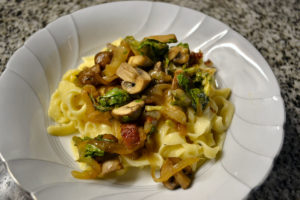

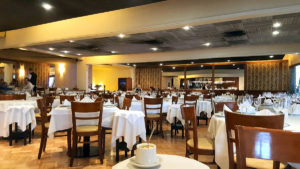
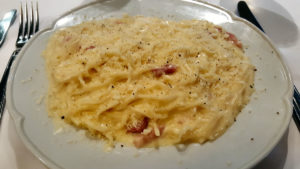
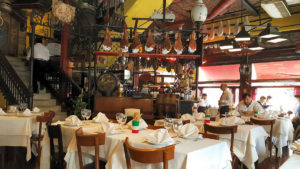
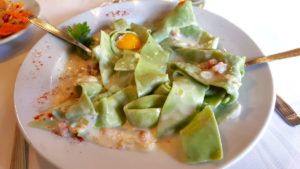
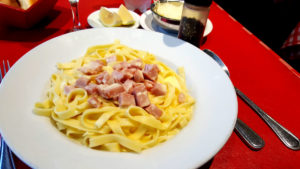
Last night we watched ‘E il cibo va’ on Netflix and they showed the restaurant L’Adesso here in Buenos Aires doing a genuine carbonara. The chef is Italian. The footage of Argentinian restaurants cooking ‘italian’ pasta was not for the (Italian) faint of heart. Also the pizza makers in Argentina and the US left my stomach upset. Ouch!
I never went to L’Adesso. The only carbonara I had here was at Mauro.it. I am sure at Giulio’s they make a genuine carbonara, as well. It is just cheaper to make at home 😉
As far as I know, Giulio’s doesn’t offer a carbonara, though I have no doubt they could if they chose. I’ll have to check out L’Adesso if they are making it right! They don’t list one on their online menu, so I hadn’t put it on my list to check out. Interestingly, in another video, Salgado Alimentos, which I normally like quite a bit, demonstrates making it, but uses cream. Mauro is on my list to go back and check out, because yes, I know he makes it without cream – though various critics have said he overloads it with pancetta. We shall see! And yes – it’s an easy and cheap dish to make at home – another reason I rarely bother to order when out.
Okay, I can’t resist. My friend Robert in Miami sent me this…
[…] the agonies of last year’s search for a decent carbonara sauce in this city – here and here. So these folks get some things right and some things not quite there. No cream, that’s a […]
[…] Edit: This “series” continues with a second post. […]
[…] alla carbonara here. A subject that I devoted a bit of time and exploration to: here, here, and here. In fact, I did a little demo of the process of making the dish at the end of the third […]